Clinical Case of Diabetes
VerifiedAdded on 2023/01/19
|6
|1657
|73
AI Summary
This article discusses a clinical case of diabetes and explores the necessary nursing interventions and medication management for the patient. It highlights the priorities for medication management and emphasizes the importance of self-management in diabetes care. The article also touches upon the application of clinical reasoning in understanding the patient's condition and devising an appropriate nursing care plan.
Contribute Materials
Your contribution can guide someone’s learning journey. Share your
documents today.
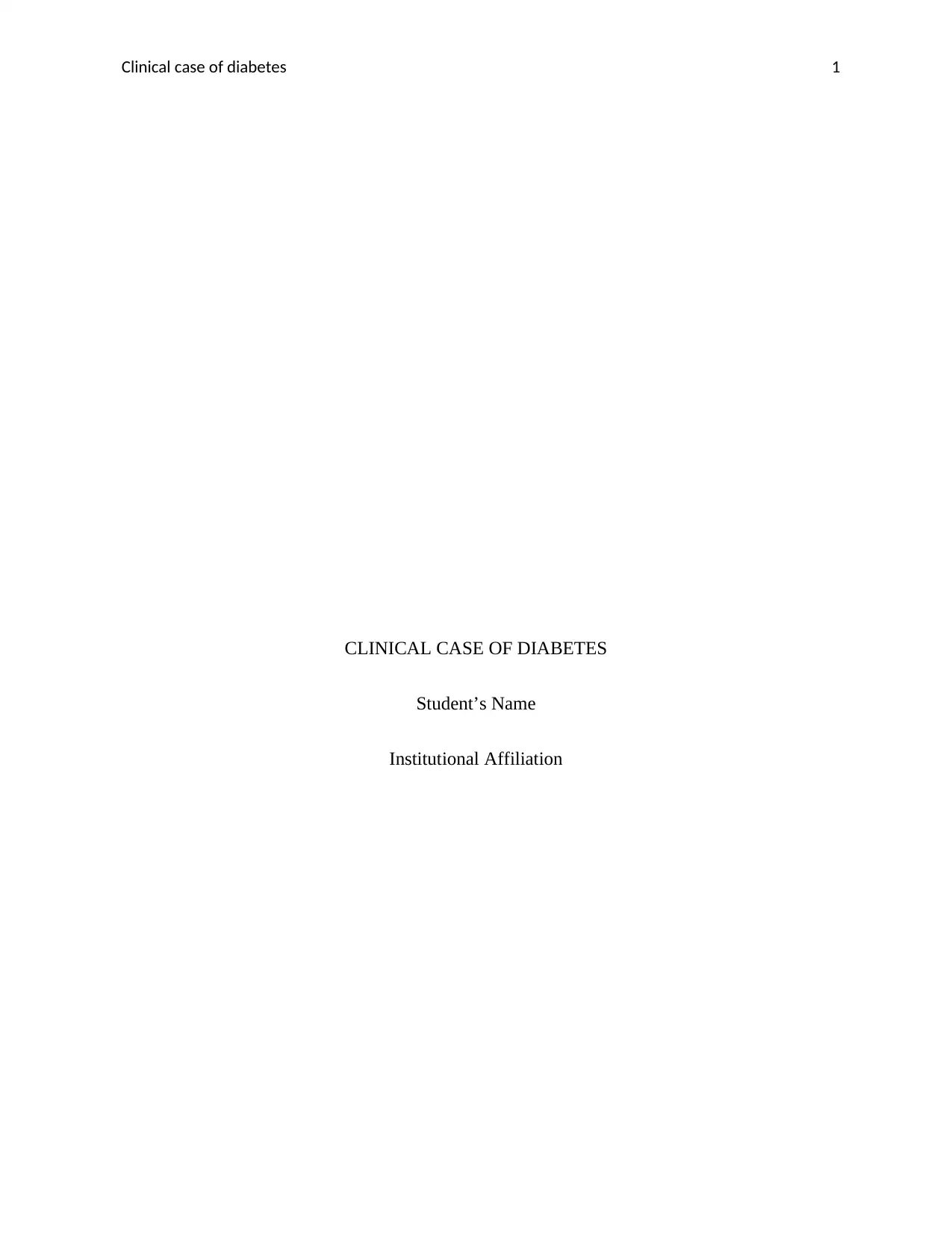
Clinical case of diabetes 1
CLINICAL CASE OF DIABETES
Student’s Name
Institutional Affiliation
CLINICAL CASE OF DIABETES
Student’s Name
Institutional Affiliation
Secure Best Marks with AI Grader
Need help grading? Try our AI Grader for instant feedback on your assignments.

Clinical case of diabetes 2
Introduction
Diabetes is a medical condition that is characterized by increased blood glucose above
the normal range. There are two types of diabetes. Type 1 diabetes mainly affects children and is
as a result of low insulin production by beta cells of the pancreas (Marso et al, 2016). The
pancreas is responsible for insulin production. This hormone is responsible for regulating blood
sugar levels by stimulating glucose intake by cells and tissues. It therefore reduces blood glucose
levels back to normal levels in case of a rise. Low insulin production in the pancreas may be due
to low number of beta cells than normal as well as genetic malfunction of insulin coding and
formation. Type 2 diabetes on the other hand mainly affects adults and is as a result of peripheral
resistance of insulin uptake by cells and tissues.
Insulin uptake by peripheral tissues is of importance to induce changes and promote
glucose intake from blood (Atlas, 2015). In type 2 diabetes however there is limited uptake of the
hormone resulting to no changes in the blood sugar levels. Marcel is suffering from diabetes and
there are several nursing implications related to his case. The aim of this discussion is therefore
to critically analyze Marcel’s case study and to describe the necessary nursing interventions and
rationales for his clinical management.
Priorities for Marcel’s medication management
After enough clinical considerations of Marcel’s condition, there was need to establish a
treatment and care plan for the patient. There was need to identify priorities for Marcel’s
medication management including self-management. The treatment plan involves a set of
medications necessary for the management of diabetes. The priorities of medication management
highly depend on the current state of the patient and the severity of the condition (Zinman et al,
Introduction
Diabetes is a medical condition that is characterized by increased blood glucose above
the normal range. There are two types of diabetes. Type 1 diabetes mainly affects children and is
as a result of low insulin production by beta cells of the pancreas (Marso et al, 2016). The
pancreas is responsible for insulin production. This hormone is responsible for regulating blood
sugar levels by stimulating glucose intake by cells and tissues. It therefore reduces blood glucose
levels back to normal levels in case of a rise. Low insulin production in the pancreas may be due
to low number of beta cells than normal as well as genetic malfunction of insulin coding and
formation. Type 2 diabetes on the other hand mainly affects adults and is as a result of peripheral
resistance of insulin uptake by cells and tissues.
Insulin uptake by peripheral tissues is of importance to induce changes and promote
glucose intake from blood (Atlas, 2015). In type 2 diabetes however there is limited uptake of the
hormone resulting to no changes in the blood sugar levels. Marcel is suffering from diabetes and
there are several nursing implications related to his case. The aim of this discussion is therefore
to critically analyze Marcel’s case study and to describe the necessary nursing interventions and
rationales for his clinical management.
Priorities for Marcel’s medication management
After enough clinical considerations of Marcel’s condition, there was need to establish a
treatment and care plan for the patient. There was need to identify priorities for Marcel’s
medication management including self-management. The treatment plan involves a set of
medications necessary for the management of diabetes. The priorities of medication management
highly depend on the current state of the patient and the severity of the condition (Zinman et al,
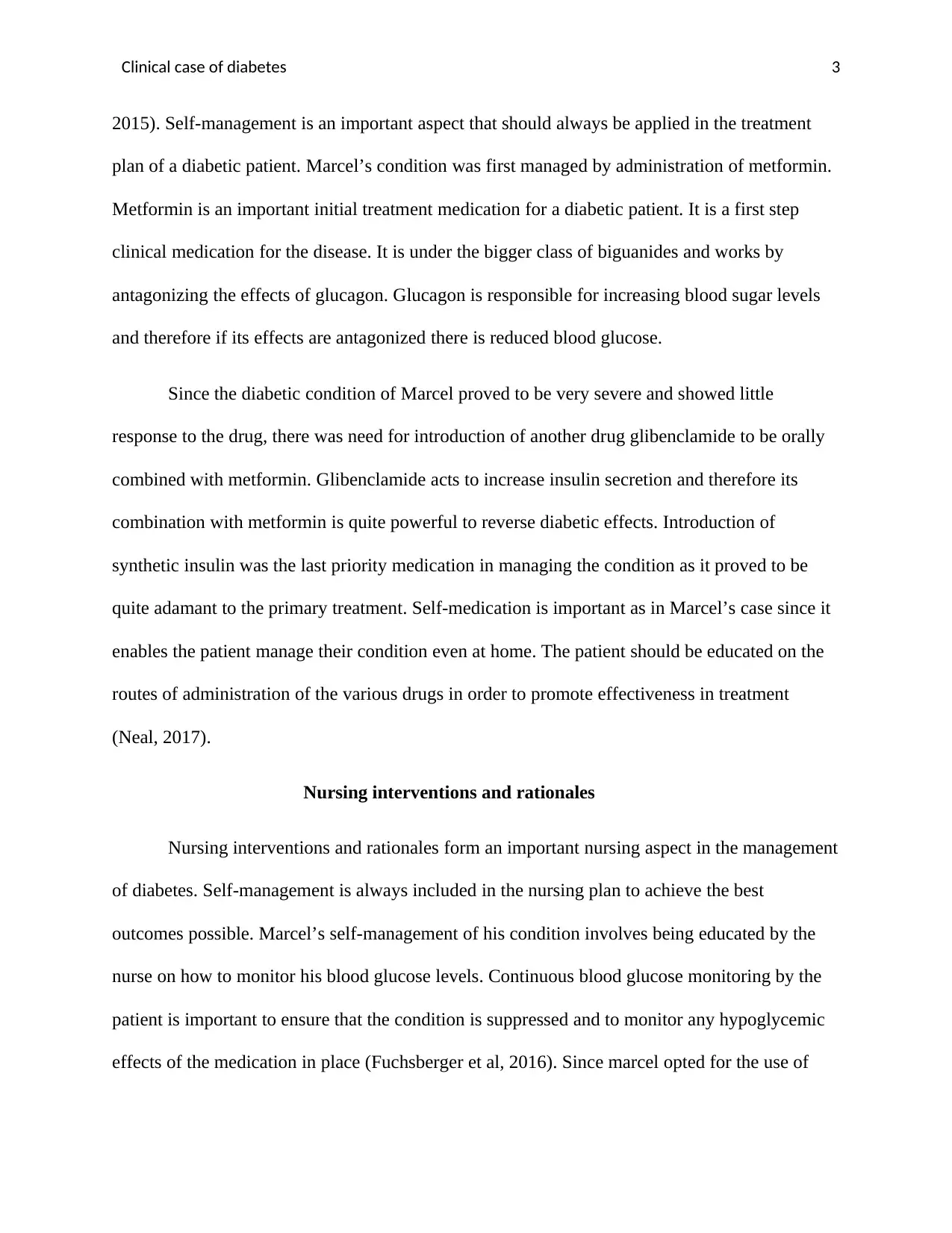
Clinical case of diabetes 3
2015). Self-management is an important aspect that should always be applied in the treatment
plan of a diabetic patient. Marcel’s condition was first managed by administration of metformin.
Metformin is an important initial treatment medication for a diabetic patient. It is a first step
clinical medication for the disease. It is under the bigger class of biguanides and works by
antagonizing the effects of glucagon. Glucagon is responsible for increasing blood sugar levels
and therefore if its effects are antagonized there is reduced blood glucose.
Since the diabetic condition of Marcel proved to be very severe and showed little
response to the drug, there was need for introduction of another drug glibenclamide to be orally
combined with metformin. Glibenclamide acts to increase insulin secretion and therefore its
combination with metformin is quite powerful to reverse diabetic effects. Introduction of
synthetic insulin was the last priority medication in managing the condition as it proved to be
quite adamant to the primary treatment. Self-medication is important as in Marcel’s case since it
enables the patient manage their condition even at home. The patient should be educated on the
routes of administration of the various drugs in order to promote effectiveness in treatment
(Neal, 2017).
Nursing interventions and rationales
Nursing interventions and rationales form an important nursing aspect in the management
of diabetes. Self-management is always included in the nursing plan to achieve the best
outcomes possible. Marcel’s self-management of his condition involves being educated by the
nurse on how to monitor his blood glucose levels. Continuous blood glucose monitoring by the
patient is important to ensure that the condition is suppressed and to monitor any hypoglycemic
effects of the medication in place (Fuchsberger et al, 2016). Since marcel opted for the use of
2015). Self-management is an important aspect that should always be applied in the treatment
plan of a diabetic patient. Marcel’s condition was first managed by administration of metformin.
Metformin is an important initial treatment medication for a diabetic patient. It is a first step
clinical medication for the disease. It is under the bigger class of biguanides and works by
antagonizing the effects of glucagon. Glucagon is responsible for increasing blood sugar levels
and therefore if its effects are antagonized there is reduced blood glucose.
Since the diabetic condition of Marcel proved to be very severe and showed little
response to the drug, there was need for introduction of another drug glibenclamide to be orally
combined with metformin. Glibenclamide acts to increase insulin secretion and therefore its
combination with metformin is quite powerful to reverse diabetic effects. Introduction of
synthetic insulin was the last priority medication in managing the condition as it proved to be
quite adamant to the primary treatment. Self-medication is important as in Marcel’s case since it
enables the patient manage their condition even at home. The patient should be educated on the
routes of administration of the various drugs in order to promote effectiveness in treatment
(Neal, 2017).
Nursing interventions and rationales
Nursing interventions and rationales form an important nursing aspect in the management
of diabetes. Self-management is always included in the nursing plan to achieve the best
outcomes possible. Marcel’s self-management of his condition involves being educated by the
nurse on how to monitor his blood glucose levels. Continuous blood glucose monitoring by the
patient is important to ensure that the condition is suppressed and to monitor any hypoglycemic
effects of the medication in place (Fuchsberger et al, 2016). Since marcel opted for the use of
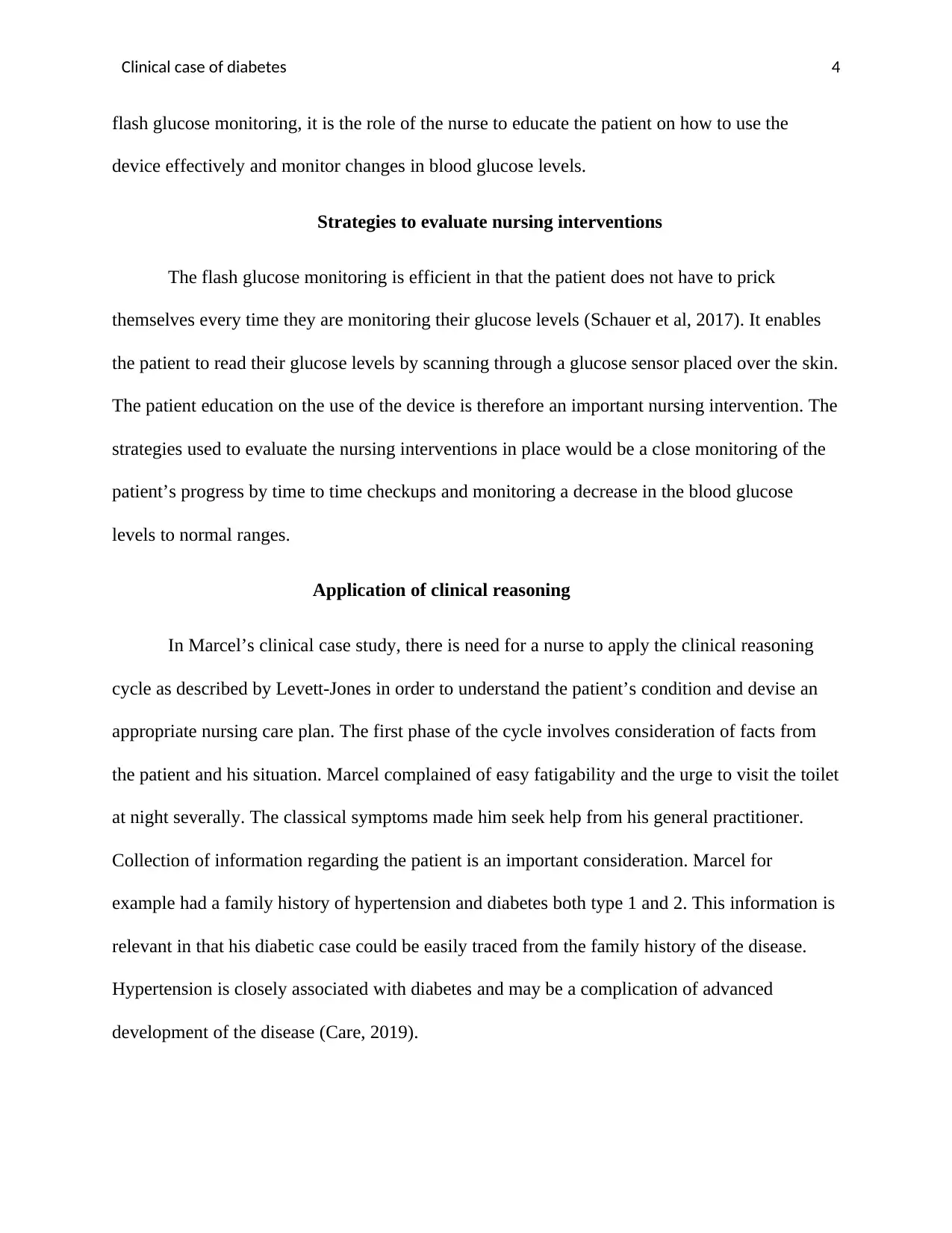
Clinical case of diabetes 4
flash glucose monitoring, it is the role of the nurse to educate the patient on how to use the
device effectively and monitor changes in blood glucose levels.
Strategies to evaluate nursing interventions
The flash glucose monitoring is efficient in that the patient does not have to prick
themselves every time they are monitoring their glucose levels (Schauer et al, 2017). It enables
the patient to read their glucose levels by scanning through a glucose sensor placed over the skin.
The patient education on the use of the device is therefore an important nursing intervention. The
strategies used to evaluate the nursing interventions in place would be a close monitoring of the
patient’s progress by time to time checkups and monitoring a decrease in the blood glucose
levels to normal ranges.
Application of clinical reasoning
In Marcel’s clinical case study, there is need for a nurse to apply the clinical reasoning
cycle as described by Levett-Jones in order to understand the patient’s condition and devise an
appropriate nursing care plan. The first phase of the cycle involves consideration of facts from
the patient and his situation. Marcel complained of easy fatigability and the urge to visit the toilet
at night severally. The classical symptoms made him seek help from his general practitioner.
Collection of information regarding the patient is an important consideration. Marcel for
example had a family history of hypertension and diabetes both type 1 and 2. This information is
relevant in that his diabetic case could be easily traced from the family history of the disease.
Hypertension is closely associated with diabetes and may be a complication of advanced
development of the disease (Care, 2019).
flash glucose monitoring, it is the role of the nurse to educate the patient on how to use the
device effectively and monitor changes in blood glucose levels.
Strategies to evaluate nursing interventions
The flash glucose monitoring is efficient in that the patient does not have to prick
themselves every time they are monitoring their glucose levels (Schauer et al, 2017). It enables
the patient to read their glucose levels by scanning through a glucose sensor placed over the skin.
The patient education on the use of the device is therefore an important nursing intervention. The
strategies used to evaluate the nursing interventions in place would be a close monitoring of the
patient’s progress by time to time checkups and monitoring a decrease in the blood glucose
levels to normal ranges.
Application of clinical reasoning
In Marcel’s clinical case study, there is need for a nurse to apply the clinical reasoning
cycle as described by Levett-Jones in order to understand the patient’s condition and devise an
appropriate nursing care plan. The first phase of the cycle involves consideration of facts from
the patient and his situation. Marcel complained of easy fatigability and the urge to visit the toilet
at night severally. The classical symptoms made him seek help from his general practitioner.
Collection of information regarding the patient is an important consideration. Marcel for
example had a family history of hypertension and diabetes both type 1 and 2. This information is
relevant in that his diabetic case could be easily traced from the family history of the disease.
Hypertension is closely associated with diabetes and may be a complication of advanced
development of the disease (Care, 2019).
Secure Best Marks with AI Grader
Need help grading? Try our AI Grader for instant feedback on your assignments.
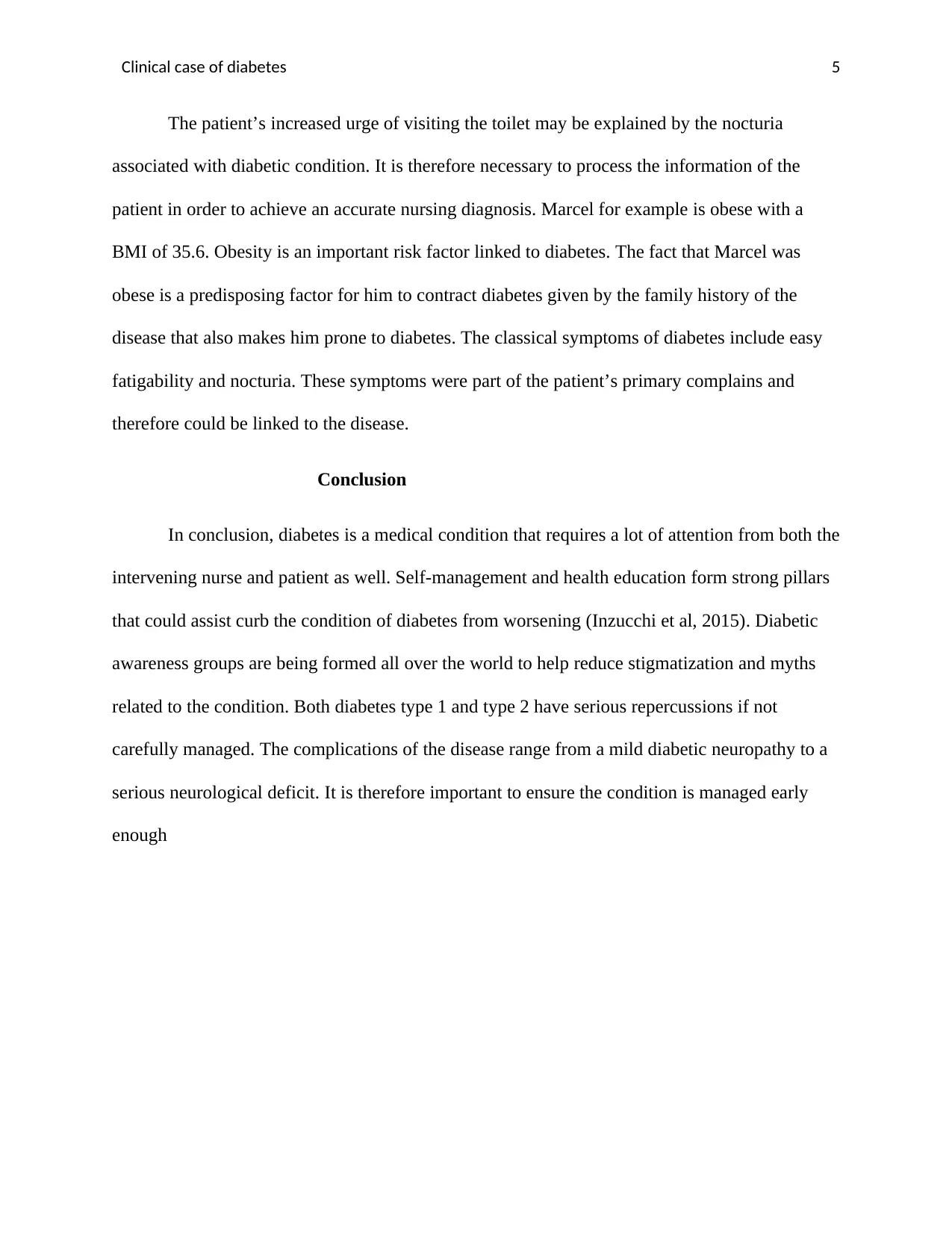
Clinical case of diabetes 5
The patient’s increased urge of visiting the toilet may be explained by the nocturia
associated with diabetic condition. It is therefore necessary to process the information of the
patient in order to achieve an accurate nursing diagnosis. Marcel for example is obese with a
BMI of 35.6. Obesity is an important risk factor linked to diabetes. The fact that Marcel was
obese is a predisposing factor for him to contract diabetes given by the family history of the
disease that also makes him prone to diabetes. The classical symptoms of diabetes include easy
fatigability and nocturia. These symptoms were part of the patient’s primary complains and
therefore could be linked to the disease.
Conclusion
In conclusion, diabetes is a medical condition that requires a lot of attention from both the
intervening nurse and patient as well. Self-management and health education form strong pillars
that could assist curb the condition of diabetes from worsening (Inzucchi et al, 2015). Diabetic
awareness groups are being formed all over the world to help reduce stigmatization and myths
related to the condition. Both diabetes type 1 and type 2 have serious repercussions if not
carefully managed. The complications of the disease range from a mild diabetic neuropathy to a
serious neurological deficit. It is therefore important to ensure the condition is managed early
enough
The patient’s increased urge of visiting the toilet may be explained by the nocturia
associated with diabetic condition. It is therefore necessary to process the information of the
patient in order to achieve an accurate nursing diagnosis. Marcel for example is obese with a
BMI of 35.6. Obesity is an important risk factor linked to diabetes. The fact that Marcel was
obese is a predisposing factor for him to contract diabetes given by the family history of the
disease that also makes him prone to diabetes. The classical symptoms of diabetes include easy
fatigability and nocturia. These symptoms were part of the patient’s primary complains and
therefore could be linked to the disease.
Conclusion
In conclusion, diabetes is a medical condition that requires a lot of attention from both the
intervening nurse and patient as well. Self-management and health education form strong pillars
that could assist curb the condition of diabetes from worsening (Inzucchi et al, 2015). Diabetic
awareness groups are being formed all over the world to help reduce stigmatization and myths
related to the condition. Both diabetes type 1 and type 2 have serious repercussions if not
carefully managed. The complications of the disease range from a mild diabetic neuropathy to a
serious neurological deficit. It is therefore important to ensure the condition is managed early
enough
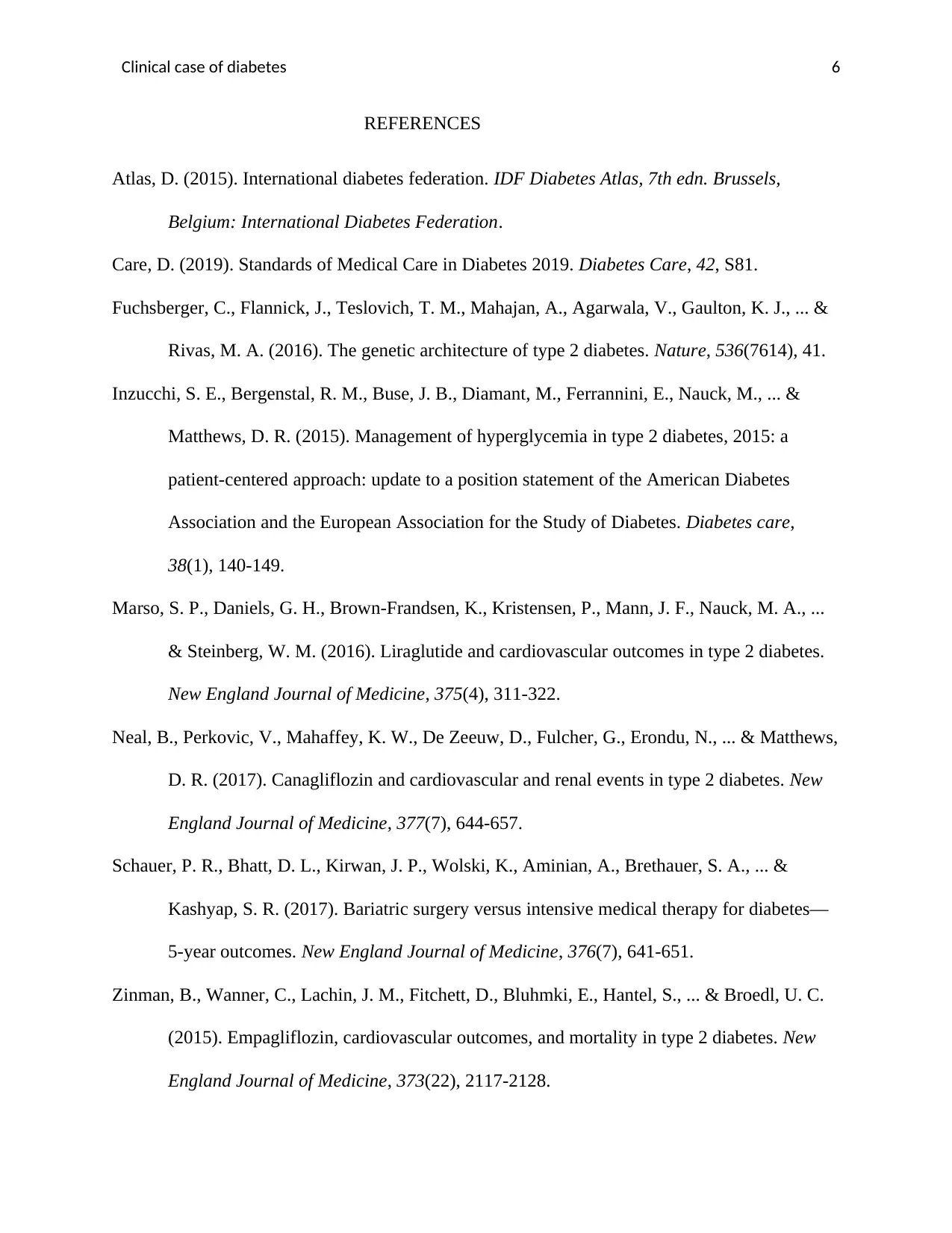
Clinical case of diabetes 6
REFERENCES
Atlas, D. (2015). International diabetes federation. IDF Diabetes Atlas, 7th edn. Brussels,
Belgium: International Diabetes Federation.
Care, D. (2019). Standards of Medical Care in Diabetes 2019. Diabetes Care, 42, S81.
Fuchsberger, C., Flannick, J., Teslovich, T. M., Mahajan, A., Agarwala, V., Gaulton, K. J., ... &
Rivas, M. A. (2016). The genetic architecture of type 2 diabetes. Nature, 536(7614), 41.
Inzucchi, S. E., Bergenstal, R. M., Buse, J. B., Diamant, M., Ferrannini, E., Nauck, M., ... &
Matthews, D. R. (2015). Management of hyperglycemia in type 2 diabetes, 2015: a
patient-centered approach: update to a position statement of the American Diabetes
Association and the European Association for the Study of Diabetes. Diabetes care,
38(1), 140-149.
Marso, S. P., Daniels, G. H., Brown-Frandsen, K., Kristensen, P., Mann, J. F., Nauck, M. A., ...
& Steinberg, W. M. (2016). Liraglutide and cardiovascular outcomes in type 2 diabetes.
New England Journal of Medicine, 375(4), 311-322.
Neal, B., Perkovic, V., Mahaffey, K. W., De Zeeuw, D., Fulcher, G., Erondu, N., ... & Matthews,
D. R. (2017). Canagliflozin and cardiovascular and renal events in type 2 diabetes. New
England Journal of Medicine, 377(7), 644-657.
Schauer, P. R., Bhatt, D. L., Kirwan, J. P., Wolski, K., Aminian, A., Brethauer, S. A., ... &
Kashyap, S. R. (2017). Bariatric surgery versus intensive medical therapy for diabetes—
5-year outcomes. New England Journal of Medicine, 376(7), 641-651.
Zinman, B., Wanner, C., Lachin, J. M., Fitchett, D., Bluhmki, E., Hantel, S., ... & Broedl, U. C.
(2015). Empagliflozin, cardiovascular outcomes, and mortality in type 2 diabetes. New
England Journal of Medicine, 373(22), 2117-2128.
REFERENCES
Atlas, D. (2015). International diabetes federation. IDF Diabetes Atlas, 7th edn. Brussels,
Belgium: International Diabetes Federation.
Care, D. (2019). Standards of Medical Care in Diabetes 2019. Diabetes Care, 42, S81.
Fuchsberger, C., Flannick, J., Teslovich, T. M., Mahajan, A., Agarwala, V., Gaulton, K. J., ... &
Rivas, M. A. (2016). The genetic architecture of type 2 diabetes. Nature, 536(7614), 41.
Inzucchi, S. E., Bergenstal, R. M., Buse, J. B., Diamant, M., Ferrannini, E., Nauck, M., ... &
Matthews, D. R. (2015). Management of hyperglycemia in type 2 diabetes, 2015: a
patient-centered approach: update to a position statement of the American Diabetes
Association and the European Association for the Study of Diabetes. Diabetes care,
38(1), 140-149.
Marso, S. P., Daniels, G. H., Brown-Frandsen, K., Kristensen, P., Mann, J. F., Nauck, M. A., ...
& Steinberg, W. M. (2016). Liraglutide and cardiovascular outcomes in type 2 diabetes.
New England Journal of Medicine, 375(4), 311-322.
Neal, B., Perkovic, V., Mahaffey, K. W., De Zeeuw, D., Fulcher, G., Erondu, N., ... & Matthews,
D. R. (2017). Canagliflozin and cardiovascular and renal events in type 2 diabetes. New
England Journal of Medicine, 377(7), 644-657.
Schauer, P. R., Bhatt, D. L., Kirwan, J. P., Wolski, K., Aminian, A., Brethauer, S. A., ... &
Kashyap, S. R. (2017). Bariatric surgery versus intensive medical therapy for diabetes—
5-year outcomes. New England Journal of Medicine, 376(7), 641-651.
Zinman, B., Wanner, C., Lachin, J. M., Fitchett, D., Bluhmki, E., Hantel, S., ... & Broedl, U. C.
(2015). Empagliflozin, cardiovascular outcomes, and mortality in type 2 diabetes. New
England Journal of Medicine, 373(22), 2117-2128.
1 out of 6
Related Documents
Your All-in-One AI-Powered Toolkit for Academic Success.
+13062052269
info@desklib.com
Available 24*7 on WhatsApp / Email
![[object Object]](/_next/static/media/star-bottom.7253800d.svg)
Unlock your academic potential
© 2024 | Zucol Services PVT LTD | All rights reserved.





